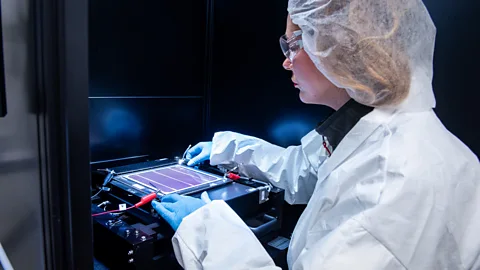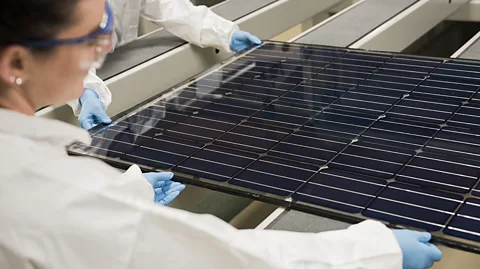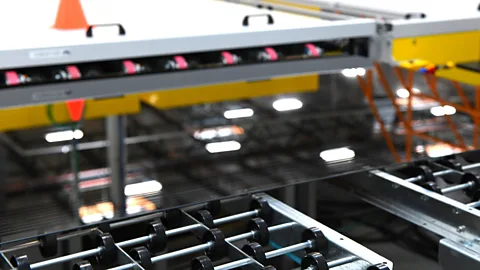
 Oxford PV
Oxford PV
At Oxford PV's German site, a researcher prepares to take a measurement of a tandem solar cell (Credit: Oxford PV)
Some argue advances in perovskite solar cells mean we are on the brink of the next solar energy revolution. But it all depends on how they hold up in the real world.
Inside a lab on the outskirts of Oxford, UK, sample solar photovoltaic (PV) cells are stacked up waiting to be put through various tests. One researcher uses an electron microscope to scan and analyse the cells for impurities that could impact efficiency. Another measures cells' response to changes in the light spectrum.
The lab is run by Oxford PV, a spin-off from Oxford University, one of several start-ups around the world developing what some argue is the game-changing next generation of solar power: tandem perovskite solar cells.
The technology combines silicon, the material currently used in solar photovoltaics (PV) in panels across the world, with perovskite materials to massively increase the efficiency of solar panels' conversion of sunlight to electricity.
Perovskite is a mineral first discovered in the Ural Mountains in Eurasia in 1839. But the name today refers to various materials made synthetically with crystal structures that mirror that of the mineral. It can be manufactured from materials such as bromine, chlorine, lead and tin, which are all readily available today.
Conventional silicon panels dominate today's solar PV market, but their efficiency has a relatively low upper limit
According to proponents of this "wonder material", perovskite panels promise to cheaply boost the energy generated by solar farms and rooftops, and could work far better than silicon panels on satellites and electric cars.
But critics of the technology worry that perovskite's greater susceptibility to moisture and heat will mean faster degradation. They are also concerned about perovskites generally containing lead, a toxic substance which can have health and environmental impacts.
Many of the start-ups and researchers working to overcome these hurdles believe that tandem panels are now ready to go mainstream. But despite the efficiency records piling out from labs, it is yet to be proven they will achieve tangible results in the real world.
The new solar
Solar power now accounts for almost 7% of global electricity generation and is rising fast: it grew by 29% in 2024. It has also become the second-cheapest new source of electricity globally, including in the US (only onshore wind is cheaper). A 2023 analysis found the trajectory of solar technology may have already reached a tipping point towards dominating global electricity markets, even without further climate policies.

 Oxford PV
Oxford PV
Conventional silicon panels dominate today's solar PV market, but their efficiency (a measure of the amount of sunlight converted to energy) has a relatively low upper limit. Efficiency is key for renewables, since expanding growth at the scale needed for global decarbonisation relies on producing the highest level of energy for the lowest possible cost.
The main advantage of perovskites over silicon is that they can convert more of the light spectrum into energy, due to a combination of factors including high mobility of electrons inside the cells.
Perovskite cells can be used by themselves in some applications. They are ultra-thin, meaning they can be sprayed onto surfaces, such as windows, with a number of companies currently piloting this technology. But using perovskites in tandem with silicon gives the benefits of both silicon and perovskites in terms of absorbing the Sun's energy. Silicon-only cells typically have an efficiency of 21-23% and though improvements are possible, the theoretical maximum is around 33%. In perovskite tandem solar cells the theoretical maximum efficiency increases to more than 47%.
Oxford PV says the ability of these panels to generate more power over the same area will reduce the cost of electricity by around 10% compared with standard silicon panels, according to its own internal analysis.
In Oxford PV's lab, an environmental chamber carries out 'accelerated ageing tests', where test cells are exposed to extreme conditions simulating years of environmental exposure in weeks or months
When discussion on them started in the late 2000s, tandem panels were initially met with scepticism in the industry, with many believing they were simply too good to be true, says David Ward, chief executive of Oxford PV. "Putting two cells together to absorb more sunlight has been known in the past, but it has been very expensive," he adds. "A combination called gallium arsenide works on the same principle, but it's significantly more expensive than silicon."
Perovskite tandem solar panels have their downsides too. One study found the technology has up to 7% higher environmental impact per panel than normal silicon solar PV, due to the extra processes needed for manufacturing, although it also noted that their increased output more than compensates for this, since fewer panels are needed for the same amount of energy.
Perovskites are also susceptible to moisture and high temperatures, and early products were far less durable and stable than silicon. The small amount of lead – a toxic substance – inside the panels has also raised eyebrows.

 Oxford PV
Oxford PV
However, when compared with the energy output of the panels, the scale of lead used is tiny, and much lower than for the same amount of energy produced by burning coal, according to Joseph Berry, a researcher at the US National Renewable Energy Laboratory, which studies the commercially viability of perovskites for solar technology. Any toxicity problems when disposing of the panels could be avoided through designing appropriate recycling or reuse processes, he adds.
Oxford PV says that its panels are designed to be recycled in the same way as standard silicon panels (which also contain lead). The solar industry at large is looking at how best to recycle panels, including lead.
Real world benefits?
In Oxford PV's lab, operations are laser focussed on solving tandem solar cells' remaining technical issues.
Here, an environmental chamber carries out "accelerated ageing tests", where test cells are exposed to extreme conditions such as high heat, humidity and rapid hot-cold cycles, simulating years of environmental exposure in weeks or months. "These tests give an idea of how the cells could degrade in the field under various conditions without having to wait five, 10 or 15 years," says Laura Miranda, Oxford PV's head of sustainability.
Considering perovskite's sensitivity to moisture and heat, data showing its long-term reliability will be vital for commercialisation. But it's hard to come by in such a young technology, says Berry. "Manufacturers of silicon modules can guarantee 30-year lifetimes because they've got 30 years of field data," he says. "But for perovskites, knowing that the module we're making today is going to last 30 years is a really hard material science question."
The rapid pace of development means real-world field tests are not going to provide the answers, he adds. "The devices we were making 10 years ago are not relevant to what's reliable now."
In any case, while tandem cells degrade faster than silicon-only ones, it's the extra power they produce that matters for viability, according to Scott Graybeal, chief executive of Caelux, a US-based spin-off from the California Institute of Technology also developing perovskite tandem cells.
"The real value here is how much energy are you going to produce over the term of a power purchase contract," he says. "That's what folks care about."
Oxford PV's efforts appear to be paying off. In 2024 it set a new record for the world's most-efficient residential-size solar module, achieving a 26.9% conversion efficiency. It believes its research and development programme will continue to improve its cells' efficiency by one percentage point a year.

 Caelux
Caelux
Other tandem perovskite players have been hitting headlines with efficiencies of more than 30%, but these are often lab-scale tests for cells not yet on the market. According to Japanese expert Tsutomu Miyasaka, whose team was the first to use perovskites for solar power applications in 2009, records achieved for lab-made cells generally represent "champion" cells that perform better than larger panels manufactured in factories, where quality can be inconsistent over large areas.
Berry highlights that the data a company claims in commercial spec sheets to buyers is more representative of performance. "If they're able to close the gap between this and their record, that is meaningful," he says.
Oxford PV says it is now manufacturing its cells at a factory in Germany and recently sent its first pilot of around 100kW of tandem solar panels (enough to power around 14 average US households) to a commercial-scale solar farm in the US. These solar models have an efficiency of 24.5%, Oxford PV says, and their performance will be closely monitored. "We want our panels tested in multiple different parts of the world so we can build a dataset of performance," says Ward.
The company is not alone in pushing ahead with scale-up. In June 2025, Swift Solar, a spinout from US universities Massachusetts Institute of Technology (MIT) and Stanford, announced a pilot with communications-infrastructure firm American Tower Corporation to deploy its perovskite tandem panels across some of its 42,000 telecommunications towers. Boston-based CubicPV and NREL have achieved 24% efficiency in tandem cells. And Caelux recently sent out its first commercial shipment of its Active Glass perovskite technology.
Firms in China, the world's largest solar market by far, are also moving fast. In April 2025, Changzhou-based solar giant Trinasolar reportedly announced a new world-record conversion efficiency of 31.1% on a tandem solar cell, and Oxford PV recently signed a deal to allow the firm to license its technology in China's domestic market. Other firms have announced high conversion efficiencies of their own, including Shanghai-based Longi which says it has achieved a 33.9% efficiency for a single cell.
Cars and spacecrafts
While the main push among these developers is to make tandem panels mainstream on solar farms and rooftops, some are also exploring other new uses for them. They say their higher efficiency could make them particularly suited to several niche uses – such as putting solar panels on the roof of electric cars.

 Getty Images
Getty Images
Tandem solar panels could provide emergency reserve capacity if a driver runs short of power en route to a charging station, says Graybeal, whose company Caelux is in discussions with "some of the major" automotive manufacturers about testing their products. "You can't run a vehicle solely off solar because it's a lot of weight to push around, but providing a trickle charge to the battery to give a little extended range is absolutely a possibility," he says.
Oxford PV is also in discussions with the automotive sector about using their panels on electric vehicles. "Cars are mostly sat in the open for big chunks of the day – why would you not want to harvest that power?" says Ward.
More like this:
• The liquid air alternative to fossil fuels
Tandem perovskite panels are also being eyed for potential space applications, such as powering satellites. Solar power in space has traditionally been generated using solar panels made from gallium arsenide, since it is both more efficient than silicon and can cope far better with the high temperatures and radiation found in space. But tandem perovskite panels have the same benefits at a far lower cost – important for the new generation of cheaper satellites with shorter lifespans being sent up today, says Ward.
Development of products for space is in the early stages, he acknowledges, noting that Oxford PV is talking to "a number of people" about it.
Graybeal admits that even for uses on solar farms and rooftops, things are still "just at the start" for perovskite tandem cells. But he believes the solar sector is "inexorably shifting" to the technology. "It's going to be utterly transformational," he says.
For Berry, the key now is to see how tandem perovskite panels perform in the real world. "It's one thing to think that you've got something durable, but it's another to show it out in the field. While we expect the perovskite to be what really drives a lot of the different aspects of performance out in the real world, we need to see that."
--
For essential climate news and hopeful developments to your inbox, sign up to the Future Earth newsletter, while The Essential List delivers a handpicked selection of features and insights twice a week.
For more science, technology, environment and health stories from the BBC, follow us on Facebook and Instagram.
.png)



